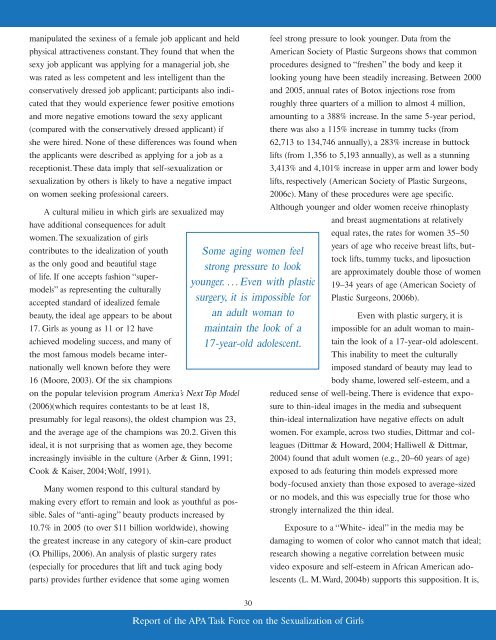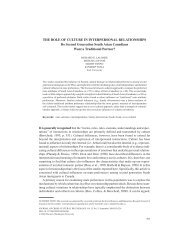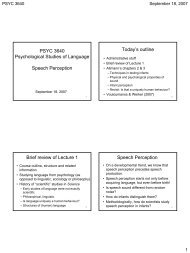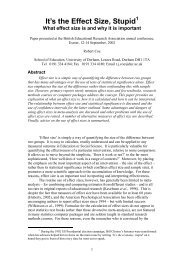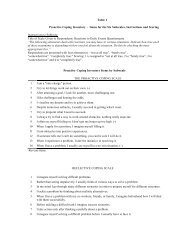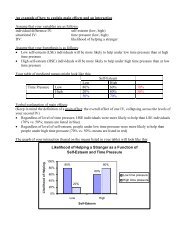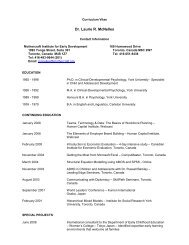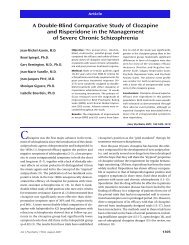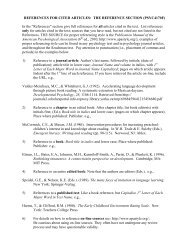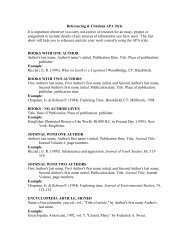SexualizationofWomen.. - Department of Psychology - York University
SexualizationofWomen.. - Department of Psychology - York University
SexualizationofWomen.. - Department of Psychology - York University
Create successful ePaper yourself
Turn your PDF publications into a flip-book with our unique Google optimized e-Paper software.
manipulated the sexiness <strong>of</strong> a female job applicant and held<br />
physical attractiveness constant.They found that when the<br />
sexy job applicant was applying for a managerial job, she<br />
was rated as less competent and less intelligent than the<br />
conservatively dressed job applicant; participants also indi-<br />
cated that they would experience fewer positive emotions<br />
and more negative emotions toward the sexy applicant<br />
(compared with the conservatively dressed applicant) if<br />
she were hired. None <strong>of</strong> these differences was found when<br />
the applicants were described as applying for a job as a<br />
receptionist.These data imply that self-sexualization or<br />
sexualization by others is likely to have a negative impact<br />
on women seeking pr<strong>of</strong>essional careers.<br />
A cultural milieu in which girls are sexualized may<br />
have additional consequences for adult<br />
women.The sexualization <strong>of</strong> girls<br />
contributes to the idealization <strong>of</strong> youth<br />
as the only good and beautiful stage<br />
<strong>of</strong> life. If one accepts fashion “super-<br />
models” as representing the culturally<br />
accepted standard <strong>of</strong> idealized female<br />
beauty, the ideal age appears to be about<br />
17. Girls as young as 11 or 12 have<br />
achieved modeling success, and many <strong>of</strong><br />
the most famous models became inter-<br />
nationally well known before they were<br />
16 (Moore, 2003). Of the six champions<br />
on the popular television program America’s Next Top Model<br />
(2006)(which requires contestants to be at least 18,<br />
presumably for legal reasons), the oldest champion was 23,<br />
and the average age <strong>of</strong> the champions was 20.2. Given this<br />
ideal, it is not surprising that as women age, they become<br />
increasingly invisible in the culture (Arber & Ginn, 1991;<br />
Cook & Kaiser, 2004;Wolf, 1991).<br />
Many women respond to this cultural standard by<br />
making every effort to remain and look as youthful as pos-<br />
sible. Sales <strong>of</strong> “anti-aging” beauty products increased by<br />
10.7% in 2005 (to over $11 billion worldwide), showing<br />
the greatest increase in any category <strong>of</strong> skin-care product<br />
(O. Phillips, 2006). An analysis <strong>of</strong> plastic surgery rates<br />
(especially for procedures that lift and tuck aging body<br />
parts) provides further evidence that some aging women<br />
Some aging women feel<br />
strong pressure to look<br />
younger. . . . Even with plastic<br />
surgery, it is impossible for<br />
an adult woman to<br />
maintain the look <strong>of</strong> a<br />
17-year-old adolescent.<br />
30<br />
feel strong pressure to look younger. Data from the<br />
American Society <strong>of</strong> Plastic Surgeons shows that common<br />
procedures designed to “freshen” the body and keep it<br />
looking young have been steadily increasing. Between 2000<br />
and 2005, annual rates <strong>of</strong> Botox injections rose from<br />
roughly three quarters <strong>of</strong> a million to almost 4 million,<br />
amounting to a 388% increase. In the same 5-year period,<br />
there was also a 115% increase in tummy tucks (from<br />
62,713 to 134,746 annually), a 283% increase in buttock<br />
lifts (from 1,356 to 5,193 annually), as well as a stunning<br />
3,413% and 4,101% increase in upper arm and lower body<br />
lifts, respectively (American Society <strong>of</strong> Plastic Surgeons,<br />
2006c). Many <strong>of</strong> these procedures were age specific.<br />
Although younger and older women receive rhinoplasty<br />
and breast augmentations at relatively<br />
equal rates, the rates for women 35–50<br />
years <strong>of</strong> age who receive breast lifts, but-<br />
tock lifts, tummy tucks, and liposuction<br />
are approximately double those <strong>of</strong> women<br />
19–34 years <strong>of</strong> age (American Society <strong>of</strong><br />
Plastic Surgeons, 2006b).<br />
Even with plastic surgery, it is<br />
impossible for an adult woman to main-<br />
tain the look <strong>of</strong> a 17-year-old adolescent.<br />
This inability to meet the culturally<br />
imposed standard <strong>of</strong> beauty may lead to<br />
body shame, lowered self-esteem, and a<br />
reduced sense <strong>of</strong> well-being.There is evidence that expo-<br />
sure to thin-ideal images in the media and subsequent<br />
thin-ideal internalization have negative effects on adult<br />
women. For example, across two studies, Dittmar and col-<br />
leagues (Dittmar & Howard, 2004; Halliwell & Dittmar,<br />
2004) found that adult women (e.g., 20–60 years <strong>of</strong> age)<br />
exposed to ads featuring thin models expressed more<br />
body-focused anxiety than those exposed to average-sized<br />
or no models, and this was especially true for those who<br />
strongly internalized the thin ideal.<br />
Report <strong>of</strong> the APA Task Force on the Sexualization <strong>of</strong> Girls<br />
Exposure to a “White- ideal” in the media may be<br />
damaging to women <strong>of</strong> color who cannot match that ideal;<br />
research showing a negative correlation between music<br />
video exposure and self-esteem in African American ado-<br />
lescents (L. M.Ward, 2004b) supports this supposition. It is,


